This is where I will put my embroidery patterns formerly resident on wiseNeedle, links to patterns hidden away in String-or-Nothing’s past posts, plus some other freebies from my notebooks. You’ll also find more stitching patterns under the “My Books” button above, including the free offering Ensamplario Atlantio: Being a Collection of Filling Patterns Suitable for Blackwork Embroidery.
If you are looking for the Epic Fandom Stitch-Along, it’s so big that it has its own page containing all 19 sampler bands. Click here to redirect to giant robots, pirates, spaceships, dinosaurs, bug eyed aliens, flying cars, Weeping angels, and more.
Block Unit Graphs (Well, mostly block units…)
Plain block unit graphs also appear in the embroidery pattern section. They work well for counted embroidery including cross stitch and its variants; lacis; darned net, drawn or pulled thread work; withdrawn thread work; filet crochet; knitting and double knitting; tiles and mosaics, marquetry, and other crafts.
The Old Castle, 16-17th Century
| My redaction of an late 16th/early 17th century graphed pattern, charted from an extant museum artifact. I explain source and dedication to SCA Clan Oldcastle in this post from February 2010. |
Heraldic Lion, 1597
| I included this Sibmacher 1597 pattern in The New Carolingian Modelbook. Shortly after the first Harry Potter book became available in the US (and long before the movies), I released it in case folk wanted to knit Gryffindor sweaters as they are described in the book. Needless to say, it earned me some unwelcome attention later on, so it’s been retitled with a more generic name. |
Da Sera 1546 Knot and Bud
| Another The New Carolingian Modelbook excerpt. This one was charted up from a pattern appearing in Domenico Da Sera’s 1546 Opera Nova… You can find that entire work at Kathryn Goodwyn’s Flowers of the Needle.The astute will notice that I’ve used this pattern here twice. Once embroidered and once knit, in the Knot a Hat earwarmer band appearing on my knitting patterns page. |
Checked All-Over Ground, 1546
| Also from the Da Sera 1546 work referenced above, this pattern is included in The New Carolingian Modelbook, too. |
Sibmacher’s Hare, 1597
| Like the lion above, this hare is from Johan Sibmacher’s Schon Neues Modelbuch of 1597. It appeared in The New Carolingian Modelbook. I’ve used it both in stitching and knitting, although those projects predated on-line documentation. |
Knots and Twisted Interlaces, 1532
| The basic interlace that started this rumination was published in Giovani Andrea Vavasore’s Ensamplio di Lavori, first printed in Venice in 1532. I regraphed that pattern and included it in The New Carolingian Modelbook. Since then I’ve played with it, abstracting bits and compounding the base concept. |
Dragonflies
| This one’s original, but it was inspired by patterns appearing in in Niccolo Zoppino d’Aristotle’s Ensamplio di Lavori from 1530. It’s anotherThe New Carolingian Modelbook excerpt. |
Alex’s Unicorn
| Another original pattern, but one by Elder Daughter Alex rather than me. Inspired by a yale (a heraldic splay-horned goat) appearing in various Sibmacher modelbooks of the late 1500s/early 1600s, she’s come up with a unicorn. She uses it for knitting, but it’s equally useful for stitching. |
Fleur de Lys
| Yet another of my own. I worked up this motif for a needlepoint bench cover my mom was going to make. But I’m a rotten kid, and I never finished out her design. |
Mystery Interlace
| I’m not quite sure where I got this one. It’s in my 1980s notebook, next to sourced patterns that made it into The New Carolingian Modelbook, but with no annotations. There are lots of examples of this type of interlace in historical works, but none graphed up at exactly this unit count. I suspect I doodled it up, inspired by the historical examples. I’ve used it for double knitting, but (so far) not stitching. |
Nevertheless, She Persisted
| I couldn’t resist. It was such a perfect motto for a sampler, and the irony of using an art form that requires persistence to accomplish, made perfect sense. This one was released on 10 February 2017, via Facebook and Tumblr, without any name attribution or copyright note, to be free for anyone to complete. I would love to see the end result, and will post pix of any finished items here on String, with the stitcher’s consent. |
Harsh Language | Harsh times call for harsh language. Presented as stress abatement for those in need of something to stab in a troubling and challenging time. No apologies here, page past if you are offended. |
Don’t Panic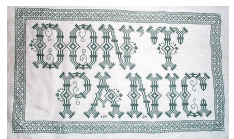 | At long last, Don’t Panic, written up as a PDF download, multi-page pattern. Intended to delight both fans of Hitchhikers’ Guide, and pragmatic realists, alike. |
Baba Yaga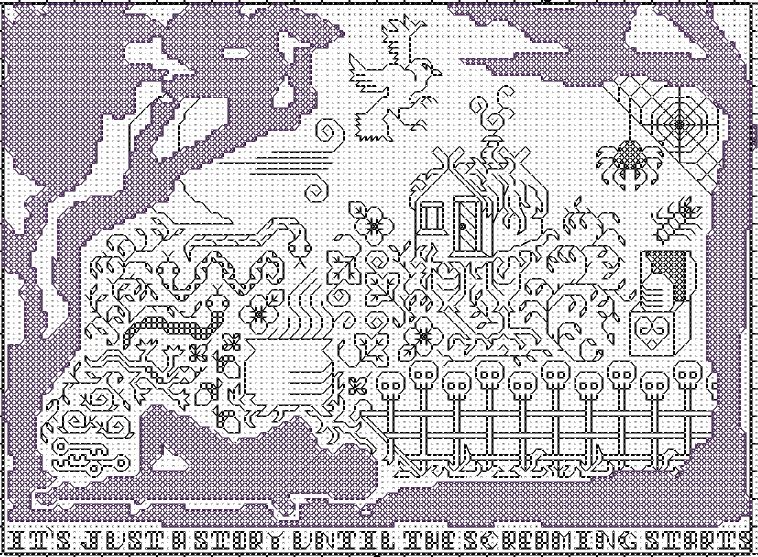 | A spooky rendition of the Baba Yaga story cycle, inspired by the work of my storyteller pal, Laura Packer. Pattern chart provided in PDF. |
Hebrew Alphabet | Hebrew alphabet and several commonly stitched simple words. Useful for samplers, wall hangings, and embroidered coverings for matzoh and bread. |
Line Unit Graphs
These patterns can be used for double running stitch embroidery (aka Holbein Stitch, Spanish Stitch, punto scritto), back stitch, or other linear techniques.
The Buttery
| An original inhabited fill pattern, inspired by Elizabethan era counted fills, but perhaps a bit more exuberant. This pattern page appeared in my book The New Carolingian Modelbook, and is dedicated to the residents of The Buttery. |
Phoenix Motif
| Another original pattern, done up for a sampler stitched for Elder Daughter. You can never have too many mythical beasts! |
Flying Spaghetti Monster
| A modern mythical beast. This time, challenged to render Noodly Glory, I came up with this rendering of The Flying Spaghetti Monster. |
Dancing Pirate Octopodes
| Just for fun – I present a pattern that did NOT make it into my formal publications. This one was done up as a silly present with several constituencies in mind – my eldest, who wanted more pirate skulls; a co-worker who cherishes the octopus as his totem beast; and my youngest, who has embarked on a world-wide quest for greater acceptance of “octopodes” as the proper plural when more than one cephalopod is sighted. |
Flower Spot Motif, 1600-1620
| This pattern is adapted from a photo of a coif and forehead cloth, dated 1600-1620 in the collections of the Manchester Art Gallery. You can find a photo at http://www.manchestergalleries.org/the-collections/search-the-collection/ by searching for item #2003.63/2. It is hard to discern on the original the exact nature of the little spot to the lower right of each flower. It may be the remains of a diamond shaped boxed cross, or four knot stitches. If I were to do a coif using this design, I’d probably sew a sequin in each of those spots instead. |
Bead Border with Corner
| Yet another New Carolingian Modelbook refugee. This border with corner is an elaboration on a design there, pairing it with a narrow edging. It’s an original, inspired by simple stepped design strips appearing in German modelbooks of the mid 1520s. |
Crowdsourced Blackwork Fill/ Ground Pattern | Finally! Our group project from Summer 2011. 40 different motifs in a framework, contributed by String-or-Nothing’s readers. This pattern is suitable for use as an all-over design. Use all 40, or a subset. Groups include traditional motifs, flowers, nautical/piratical, science fiction/fantasy, astronomy, and beasts & bugs. Authors’ names have been included, where they so requested. |
The Dance | My defiant celebration of life dancing skeletons design, plus a separate swords border, and a bonus lemon meander, in a PDF file. Note that there is NO count relationship between the main skeleton strip and its companion edges. The same with the swords strip and its companion darts. |
Class Handout | This is the handout of patterns I distribute when I teach classes on blackwork technique. The complexity of the designs increases as you move from the upper left to the lower right. |
Design for a Sleeve | Linear design adapted from the portrait of Maria Potter, painted in 1565. A fascinating YouTube video analysis of the original artwork can be found here. |
Cat and Mouse | Linear design adapted from a Batchelder’s Design and Theory in Practice, a 1910 treatise covering the roots of Mission and Art Deco styling. |
Ring of Rats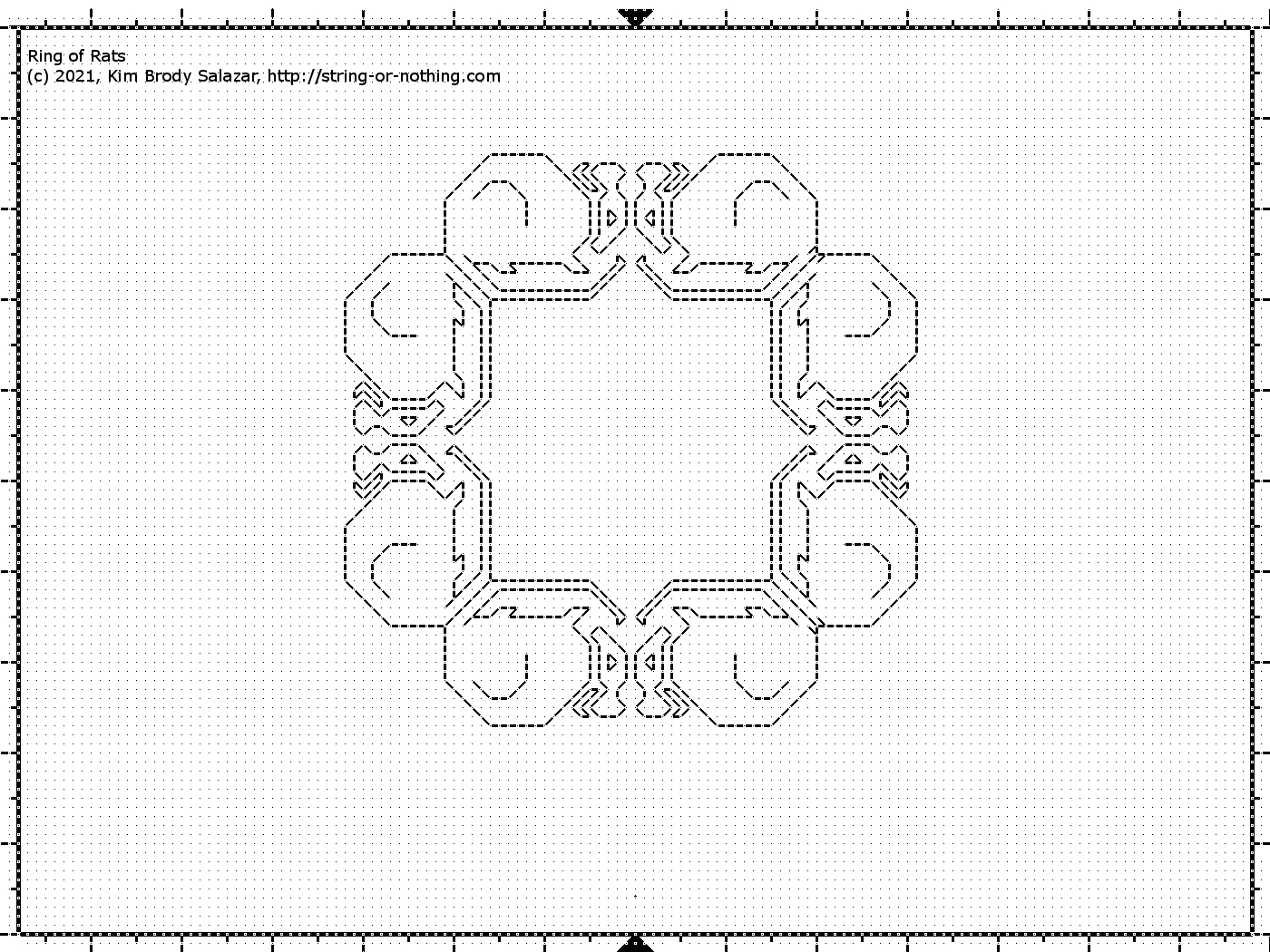 | Another linear design adapted from a Batchelder’s Design and Theory in Practice, a 1910 treatise covering the roots of Mission and Art Deco styling. |
Leopard Strip and Edging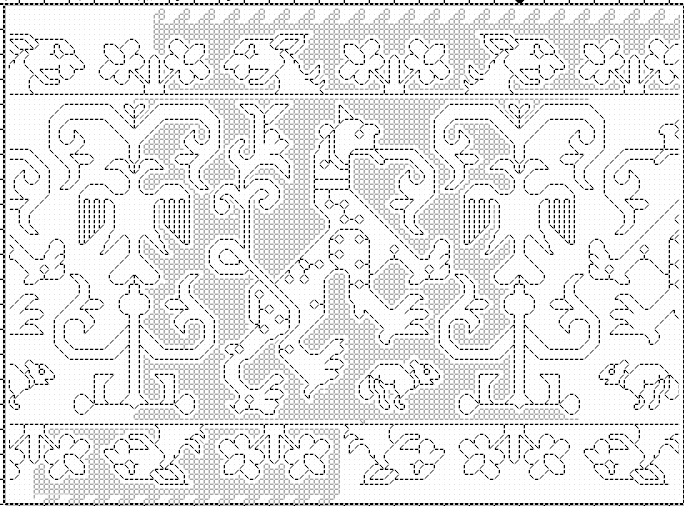 | Single sheet broadside with an adaptation of a design on a tablecloth in the collection of the Metropolitan Museum of Art, Accession 08.48.132, Spanish, Sicilian, or Italian – 15th to 16th century. |
Floral Frame and Sprig | Single sheet broadside with a redaction of the all-over floral frame and sprig design appearing on the Boston Museum of Fine Art’s Workbag, Accession 12.52. Museum provenance is Italy or England, circa 1600. |
Motifs from 16th Century Italian Camica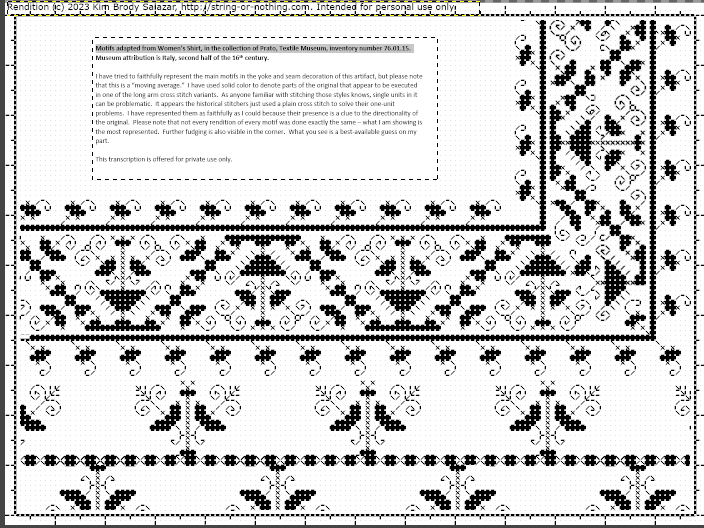 | Motifs adapted from a Woman’s Shirt in the collection of the Textile Museum, Prato, inventory 76.09.15 Includes the main yoke pattern, one corner, and the motifs that decorate the seams and lower hem. A mix of liner stitching and long armed cross stitch. |
Collar and Cuffs, 1560 | Band adapted from the collar and cuffs of a man’s shirt, as depicted in the Giovanni Battista Moroni painting, A Gentleman in Adoration before the Madonna. That painting is in the holdings of the National Gallery of Art, Accession number 1939.1.114. |
Sleeve Band, 1500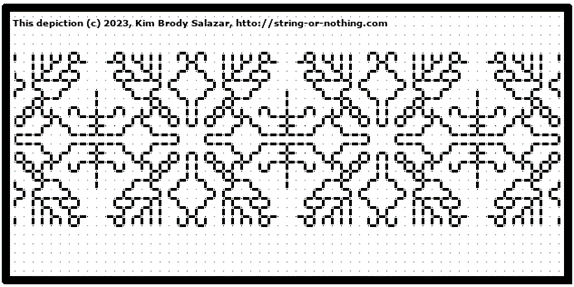 | Sleeve band after Portrait of an Unknown Young Woman, circa 1500, held by the Bristol Museum and Art Gallery, Accession K1651. |
Collar, 1530-1532 | Collar after Portrait of Francisco de Lost Cobos y Molina by Jan Gossaert, painted 1530-1532, in the collection of the J. Paul Getty Museum, Accession 88.PB.43. |
Original Band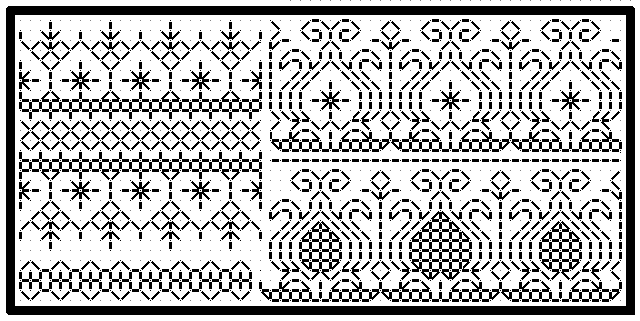 | The doodle page that I used to work up the original band pattern stitched on my chatelaine ribbon. |
Hearts & Arrows Band | Another original pattern, shared in honor of Valentine’s Day 2024. This will be in the forthcoming third volume of my Ensamplario Atlantio series. |
Thomas Howard’s Collar | Collar after Hans Holbein the Younger’s portrait –Thomas Howard, Third Duke of Norfolk (1473-1554) in the Royal Trust Collection, UK, Accession 404439. |
Elizabeth Hardwick’s Sleeves | Sleeve pattern from the portrait, Elizabeth Hardwick, Countess of Shrewsbury attributed to followers of Hans Elworth, in the Royal Trust Collection, UK, Accession 1129165 |
Persist Sampler  |
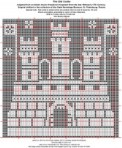
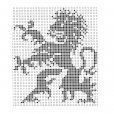

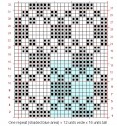

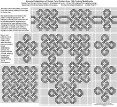




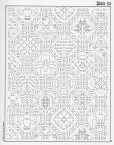
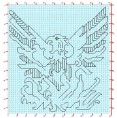
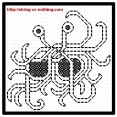
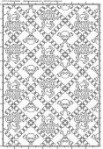


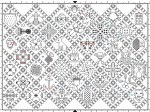
Hello- some minutes ago I found in Mary Corbeth’s blog the link to these wonderful blackwork-patterns. It is really great, to see so much possibilities- as everybody knows who gets in contact with blackwork- one is addicted at once! I embroidered a renaissance-smock with blackwork and have in work two Tudor-sleeves (long lasting history…) thank you very much for giving these patterns for free!
best regards
Martina
I too found you via Mary Corbeth’s blog…. thank you for the blackwork book – it looks too delicious for words!
Thank you for putting these on the Web.
I am another one that found your wonderful site from a link on Mary Corbeth’s blog. Your patterns are just beautiful – I am inspired to start yet another project! LOL
Thank you so much,
Beverly Smith
Noilene Bowden SCA
I just couldnt beleave my eyes. I love blackwork, I want to thank you so much for your knowledge,and the willness to share. Found you through Mary Corbeth’s blog. I shall study and use your patterns for a dress I have been plaining.
I found you, interestingly enough, on Pinterest. Can’t tell you who posted, but I am thrilled to have found you. I would also like to that you for your generosity in sharing your considerable talent. These designs are stunning!
I found your site by luck. The patterns are stunning and just what I need to make the ring pillow for my son’s wedding. I can’t thank you enough for sharing your skills.
Thanks! Best wishes to your son. Please feel free to send pix of the pillow. I vastly enjoy seeing how the patterns are used. enjoy, -k
Mary Corbett has a lot of followers! Thank you for sharing so much of yourself, too.
I found your celtic knotwork Italian c1530-40 sampler on Carol Hanson’s Dragonbear.com website (http://www.dragonbear.com/sample3.html). I would like to adapt the pattern to make a double-sided/reversible knitted blanket for a work colleague (and to show at the Royal Canberra Show in 2015). Similar to the Persian Tile Wrap I did in 2013 (http://www.ravelry.com/projects/LinMSmith/persian-tiles-2). The design on the website has been copyrighted. Can you let me know if I am able to use it for non-commercial means.
Hi Linda! Please feel free to go ahead and use that particular design. For the record, I originally published it in a leaflet long out of print: Counted Thread Patterns from Before 1600, Black Rose Press, 1986.
If you issue documentation or post on Ravelry, I’d greatly appreciate it though if you could include a link to http://string-or-nothing.com in your write-up. Thanks for asking! Delighted you like the design – K.
Thanks. I have put a link on my project page (http://www.ravelry.com/projects/LinMSmith/2014-celtic-knot-reversible-blanket). I will update the page regularly and post pictures every now and then, if you wanted to keep an eye on how it turns out.
Beautiful! Thanks so much. I wish you could make a filet crochet pattern for the Flying Spaghetti Monster.
hi, thanks for share
[…] Embroidery Patterns […]
Will you be writing a second book, please. If so when will it be available. I love your intricate work it is sensational.
I have two in the chute. I know I’ve been promising them a long time but they ARE coming.
Hey you! I just added Siebmacher’s rabbit to a project I am working on, so I wanted to say thank you! I love the historical aspect of it just as much as the motif itself! You can see my version here https://www.thecrafties.com/2020/01/shawkls-103-basic-story/
Sweet! I love the mischief the pattern children are up to, out in the wide, wide world. Your rabbit is prime, and I love the thistle flower blowing in the wind as he hops by. Best wishes for success on your crazy quilt project. I’ll be popping by to see it grow, and to render appropriate ooohs and aaahs. 🙂
broke right wrist before thanksgiving … and seems like it is never healing even with PT twice a week and my own pt at home – daily.
Just love the bunny.
FYI … the correct spelling is Mary Corbet … no ‘h’ at the end.
[…] THE OLD CASTLE GRAPH IS NOW AVAILABLE AS AN EASY TO PRINT PDF AT THE EMBROIDERY PATTERNS LINK, […]
[…] Embroidery Patterns […]
[…] Embroidery Patterns […]
[…] Embroidery Patterns […]
Hey again Kim! I don’t know if you are signed up for the Inspiration newsletter, but they recently showed the crazy quilt I’ve been working on, which features the Sibmacher’s Hare pattern so I wanted to share 😀 You can see it here https://mailchi.mp/inspirationsmagazine/embroidery-news-issue-461676?e=f5eedd3aef
I hope all is well with you!
He’s GORGEOUS! I love the peek-a-boo behind the tassel flower, and the choice of working him up on a patterned ground. It’s a delightful composition with a lot of movement and breeze happening in a very small space. Lovely work.
Thank you for making my day!
[…] Embroidery Patterns […]
[…] A few weeks into the plague, when us introverted homebodies were finally getting over the guilt of enjoying being home with our projects, Kim Salazar of String-or-Nothing released this FANTASTIC blackwork pattern of fun little dancing skeletons. I worked on this in between long bouts of killing skeletons on minecraft. I intend to pick it up again soon. To check out this pattern and others go here: https://string-or-nothing.com/embroidery-patterns/ […]
Nice chatting with you at Honda today. Yours embroidery pattern is fantastic, and it is a lot more fantastic you patiently embroidered it for your husband yourself.
Best wishes to you
George
[…] Embroidery Patterns […]
[…] Embroidery Patterns […]
[…] Embroidery Patterns […]
[…] Embroidery Patterns […]
[…] Embroidery Patterns […]
[…] Embroidery Patterns […]
[…] Embroidery Patterns […]
Que fantasias de diseños, di con uno de tus diseños en pinterest y quede fascinada, por suerte tenian el link a tu pagina, he estado revisando todo y tu trabajo es maravilloso y muy creativo, espero que continues haciendo lo que disfrutas. Muchas gracias por compartir con nosotros, desconocidos de internet, tu trabajo.
Saludos desde Chile.
[…] Embroidery Patterns […]
[…] Embroidery Patterns […]
[…] Embroidery Patterns […]
[…] Embroidery Patterns […]
[…] Embroidery Patterns […]
[…] Embroidery Patterns […]
Thank you so much for sharing your many talents! I wish you the best and quickest recovery ❤️🩹 from your cancer. It is a tough road to be sure but you have proven you know he w to persevere. -💕
[…] Embroidery Patterns […]